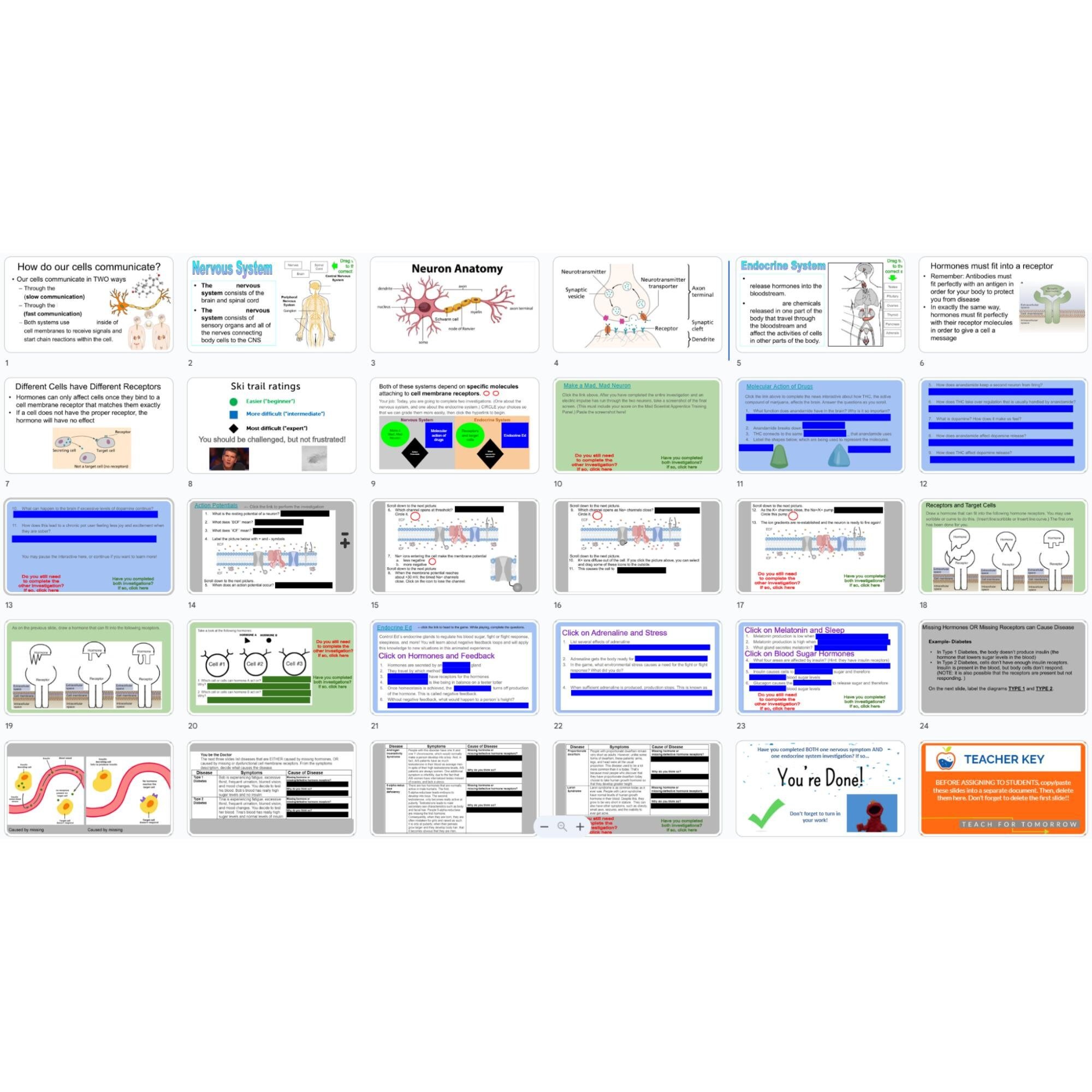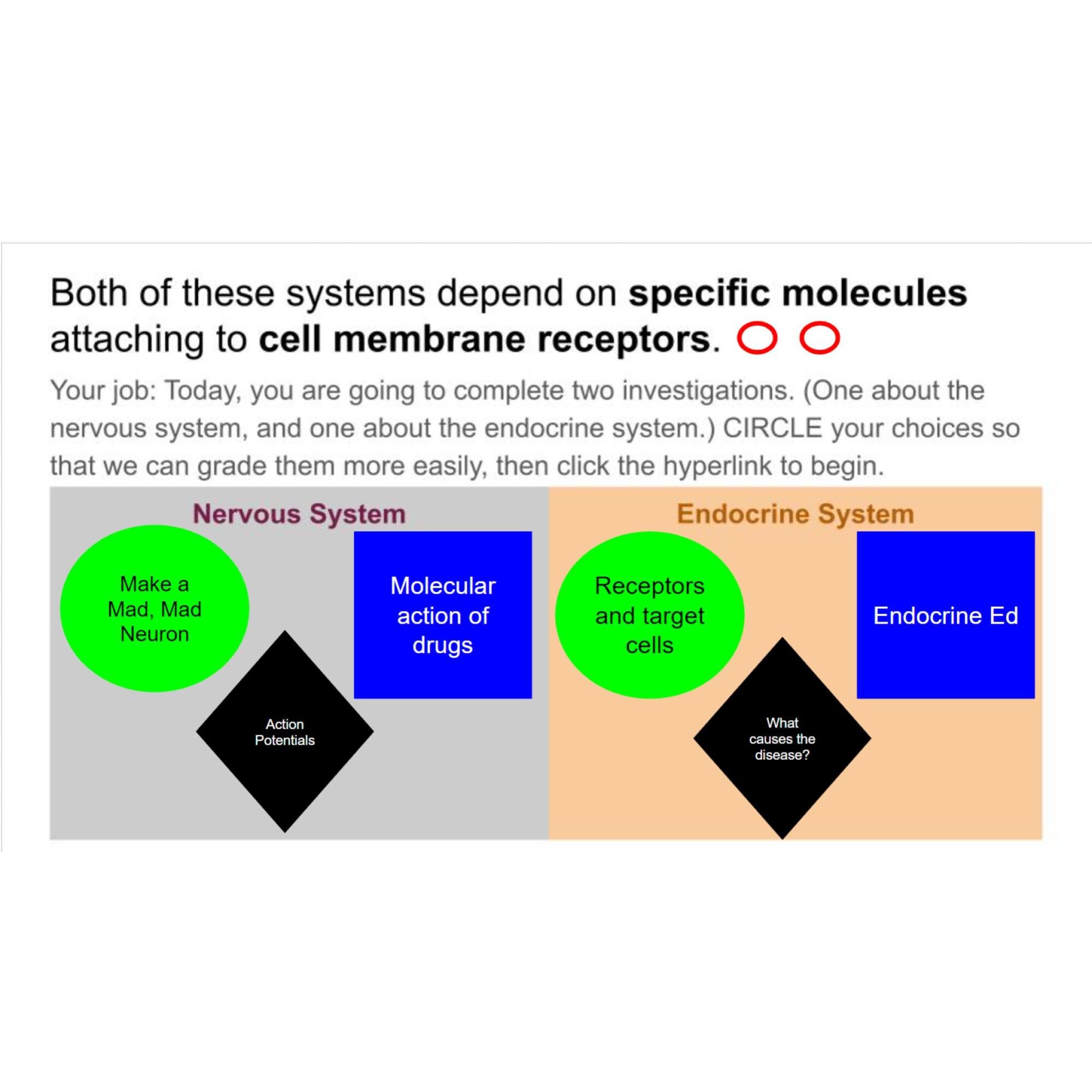 Image 1 of 4
Image 1 of 4

 Image 2 of 4
Image 2 of 4

 Image 3 of 4
Image 3 of 4

 Image 4 of 4
Image 4 of 4





How do cells communicate? (Intro to Nervous and Endocrine Systems)
Cellular Communication: A Differentiated Interactive Learning Experience!
Embark on a dynamic journey into the realms of slow and rapid cellular communication with this thoughtfully designed interactive lesson. Here's how it empowers every student in your class:
Foundational Notes: Commence with comprehensive notes on the endocrine and nervous systems, and reinforce learning by labeling anatomical diagrams. Watch knowledge come to life as vocabulary seamlessly integrates with anatomy.
Empowered Choices: The lesson offers a spectrum of task choices, ranging from the nervous system to the endocrine system. Each task is thoughtfully rated with ski hill icons - green circles for approachable tasks, blue squares for intermediate challenges, and black diamonds for the most exhilarating endeavors.
Nervous System Tasks:
Green Circle (Easiest): Craft a 'Mad, Mad Neuron' and proudly showcase your creation. Witness your neuron in action!
Blue Square (Intermediate): Dive deep into the mechanism of THC with interactive questions that unravel its secrets.
Black Diamond (Most Challenging): Navigate the intricacies of action potentials through an online lesson while addressing thought-provoking questions.
Endocrine System Tasks:
Green Circle (Easiest): Immerse in receptor binding, matching hormone shapes to binding sites, and decipher which cells respond based on receptor shape.
Blue Square (Intermediate): Engage with 'Endocrine Ed,' a captivating online game, while tackling insightful questions.
Black Diamond (Most Challenging): Decode real-world human diseases, identifying if they stem from missing hormones or malfunctioning receptors. A true test of diagnostic prowess!
Foster Engagement, Ignite Learning:
This differentiated interactive lesson transcends traditional teaching. By catering to diverse learning styles and levels, it ensures every student is not just learning, but thriving.
Empower Your Students, Transform Learning:
Download this lesson now and revolutionize your classroom. Empower your students to delve into the captivating world of cellular communication like never before.
To preview this product, highlight the link below and paste the address into your web browser.
https://docs.google.com/presentation/d/100YQgwhes6kVbicINQG4fWUndu29qArHXJ7jRK1j3GI/edit?usp=sharing
Grade & Course Recommendation:
Middle School: Grade 8 Advanced Life Science, introducing body systems and internal regulation.
High School: Grade 9–10 Biology or Anatomy/Physiology, for system interaction and homeostasis.
Cross-Curricular Connections:
Health Science Integration: Links to hormones, neurotransmitters, and physiological feedback loops.
ELA Integration: Students interpret scientific diagrams and write summaries connecting structure to function.
Math Integration: Optional inclusion of data analysis from stimulus–response timing activities.
Daily slide + literacy - based exit ticket included with purchase
Join the Lesson Laboratory and Teach for Tomorrow!
NGSS (Next Generation Science Standards)
High School NGSS Alignment
HS-LS1-2: Develop and use a model to illustrate the hierarchical organization of interacting systems that provide specific functions within multicellular organisms.
(Students model and analyze how the nervous and endocrine systems communicate to maintain function.)HS-LS1-3: Plan and conduct an investigation to provide evidence that feedback mechanisms maintain homeostasis.
(Students connect hormone signaling and neural feedback to physiological balance.)HS-LS1-8: Gather and synthesize information that sensory receptors respond to stimuli by sending messages to the brain for immediate behavior or storage as memories.
(Students explore neural signaling and response through interactive simulations and concept mapping.)
Science & Engineering Practices:
Developing and using models
Analyzing and interpreting data
Constructing explanations and designing solutions
Obtaining, evaluating, and communicating information
Crosscutting Concepts:
Systems and system models
Stability and change
Structure and function
Common Core Standards
Grades 9–10:
CCSS.ELA-LITERACY.RST.9-10.2: Determine the central ideas or conclusions of a text; trace the text’s explanation of a complex process or concept. (Students interpret scientific explanations of nerve and hormone signaling.)
CCSS.ELA-LITERACY.RST.9-10.3: Follow precisely a complex multistep procedure when carrying out experiments, taking measurements, or performing technical tasks. (Students navigate linked simulations and digital activities.)
CCSS.ELA-LITERACY.RST.9-10.7: Translate quantitative or technical information expressed in words into visual form and vice versa. (Students match diagrams of neural signaling or hormonal feedback to written explanations.)
CCSS.ELA-LITERACY.WHST.9-10.2: Write informative/explanatory texts to examine and convey complex ideas, concepts, and information clearly and accurately. (If students complete short reflections or exit tickets about signaling and homeostasis.)
Cellular Communication: A Differentiated Interactive Learning Experience!
Embark on a dynamic journey into the realms of slow and rapid cellular communication with this thoughtfully designed interactive lesson. Here's how it empowers every student in your class:
Foundational Notes: Commence with comprehensive notes on the endocrine and nervous systems, and reinforce learning by labeling anatomical diagrams. Watch knowledge come to life as vocabulary seamlessly integrates with anatomy.
Empowered Choices: The lesson offers a spectrum of task choices, ranging from the nervous system to the endocrine system. Each task is thoughtfully rated with ski hill icons - green circles for approachable tasks, blue squares for intermediate challenges, and black diamonds for the most exhilarating endeavors.
Nervous System Tasks:
Green Circle (Easiest): Craft a 'Mad, Mad Neuron' and proudly showcase your creation. Witness your neuron in action!
Blue Square (Intermediate): Dive deep into the mechanism of THC with interactive questions that unravel its secrets.
Black Diamond (Most Challenging): Navigate the intricacies of action potentials through an online lesson while addressing thought-provoking questions.
Endocrine System Tasks:
Green Circle (Easiest): Immerse in receptor binding, matching hormone shapes to binding sites, and decipher which cells respond based on receptor shape.
Blue Square (Intermediate): Engage with 'Endocrine Ed,' a captivating online game, while tackling insightful questions.
Black Diamond (Most Challenging): Decode real-world human diseases, identifying if they stem from missing hormones or malfunctioning receptors. A true test of diagnostic prowess!
Foster Engagement, Ignite Learning:
This differentiated interactive lesson transcends traditional teaching. By catering to diverse learning styles and levels, it ensures every student is not just learning, but thriving.
Empower Your Students, Transform Learning:
Download this lesson now and revolutionize your classroom. Empower your students to delve into the captivating world of cellular communication like never before.
To preview this product, highlight the link below and paste the address into your web browser.
https://docs.google.com/presentation/d/100YQgwhes6kVbicINQG4fWUndu29qArHXJ7jRK1j3GI/edit?usp=sharing
Grade & Course Recommendation:
Middle School: Grade 8 Advanced Life Science, introducing body systems and internal regulation.
High School: Grade 9–10 Biology or Anatomy/Physiology, for system interaction and homeostasis.
Cross-Curricular Connections:
Health Science Integration: Links to hormones, neurotransmitters, and physiological feedback loops.
ELA Integration: Students interpret scientific diagrams and write summaries connecting structure to function.
Math Integration: Optional inclusion of data analysis from stimulus–response timing activities.
Daily slide + literacy - based exit ticket included with purchase
Join the Lesson Laboratory and Teach for Tomorrow!
NGSS (Next Generation Science Standards)
High School NGSS Alignment
HS-LS1-2: Develop and use a model to illustrate the hierarchical organization of interacting systems that provide specific functions within multicellular organisms.
(Students model and analyze how the nervous and endocrine systems communicate to maintain function.)HS-LS1-3: Plan and conduct an investigation to provide evidence that feedback mechanisms maintain homeostasis.
(Students connect hormone signaling and neural feedback to physiological balance.)HS-LS1-8: Gather and synthesize information that sensory receptors respond to stimuli by sending messages to the brain for immediate behavior or storage as memories.
(Students explore neural signaling and response through interactive simulations and concept mapping.)
Science & Engineering Practices:
Developing and using models
Analyzing and interpreting data
Constructing explanations and designing solutions
Obtaining, evaluating, and communicating information
Crosscutting Concepts:
Systems and system models
Stability and change
Structure and function
Common Core Standards
Grades 9–10:
CCSS.ELA-LITERACY.RST.9-10.2: Determine the central ideas or conclusions of a text; trace the text’s explanation of a complex process or concept. (Students interpret scientific explanations of nerve and hormone signaling.)
CCSS.ELA-LITERACY.RST.9-10.3: Follow precisely a complex multistep procedure when carrying out experiments, taking measurements, or performing technical tasks. (Students navigate linked simulations and digital activities.)
CCSS.ELA-LITERACY.RST.9-10.7: Translate quantitative or technical information expressed in words into visual form and vice versa. (Students match diagrams of neural signaling or hormonal feedback to written explanations.)
CCSS.ELA-LITERACY.WHST.9-10.2: Write informative/explanatory texts to examine and convey complex ideas, concepts, and information clearly and accurately. (If students complete short reflections or exit tickets about signaling and homeostasis.)